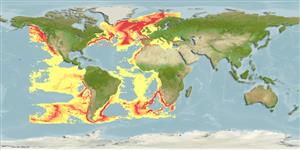Common names from other countries
Classification / Names / Names
ชื่อสามัญ | ชื่อพ้อง | Catalog of Fishes (gen., sp.) | ITIS | CoL | WoRMS
Environment: milieu / climate zone / depth range / distribution range
นิเวศวิทยา
เกี่ยวกับหินโสโครก; ระดับความลึก 27 - 4312 m (Ref. 105406). Subtropical; 75°N - 58°S, 145°W - 36°E
Eastern Pacific, Atlantic Ocean, Mediterranean Sea to the Arctic: Western to northern Europe, and Western Africa.
Length at first maturity / ขนาด / น้ำหนัก / Age
Maturity: Lm ? range ? - ? cm Max length : 2.0 cm SHH เพศผู้/กระเทย; (Ref. 90120)
Inhabits deep-water coral reef mound (Ref. 105183). It is also found in sublittoral to abyssal depths, usually attached to rocks, stones, gorgonians, or hydroids on muddy and sandy substrates (Ref. 90120). Epibionts on the trunk of the black coral Leiopathes glaberrima bush (Ref. 105183). Colonized by the parasitic foraminifer Hyrrokkin sarcophaga (Ref. 105186). Suspension feeder (Ref. 105183). In general, suspension feeding bivalves mainly depend on phytoplankton and detritus material for nutrition (Ref. 107088).
Life cycle and mating behavior
วัยเจริญพันธุ์ | การสืบพันธุ์ | การวางไข่ | เซลสืบพันธ์ของเพศเมีย(ไข่) | ความดกของไข่ | ตัวอ่อน
Members of the class Bivalvia are mostly gonochoric, some are protandric hermaphrodites. Life cycle: Embryos develop into free-swimming trocophore larvae, succeeded by the bivalve veliger, resembling a miniature clam.
Demir, M. 2003. (Ref. 2754)
IUCN Red List Status (Ref. 130435)
CITES status (Ref. 108899)
Not Evaluated
Not Evaluated
Human uses
| FishSource |
เครื่องมือ
ข้อมูลเพิ่มเติม
Age/Size
การเจริญเติบโต
Length-weight
Length-length
สัณฐานวิทยา
ตัวอ่อน
อุดมสมบรูณ์
แหล่งที่มาจากอินเตอร์เน็ต
Estimates based on models
Preferred temperature
(Ref.
115969): 2.6 - 8.7, mean 4 (based on 528 cells).
